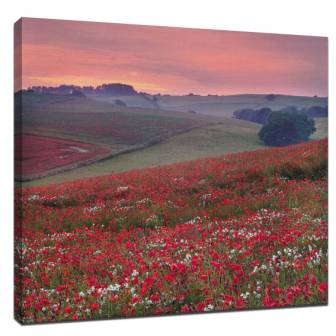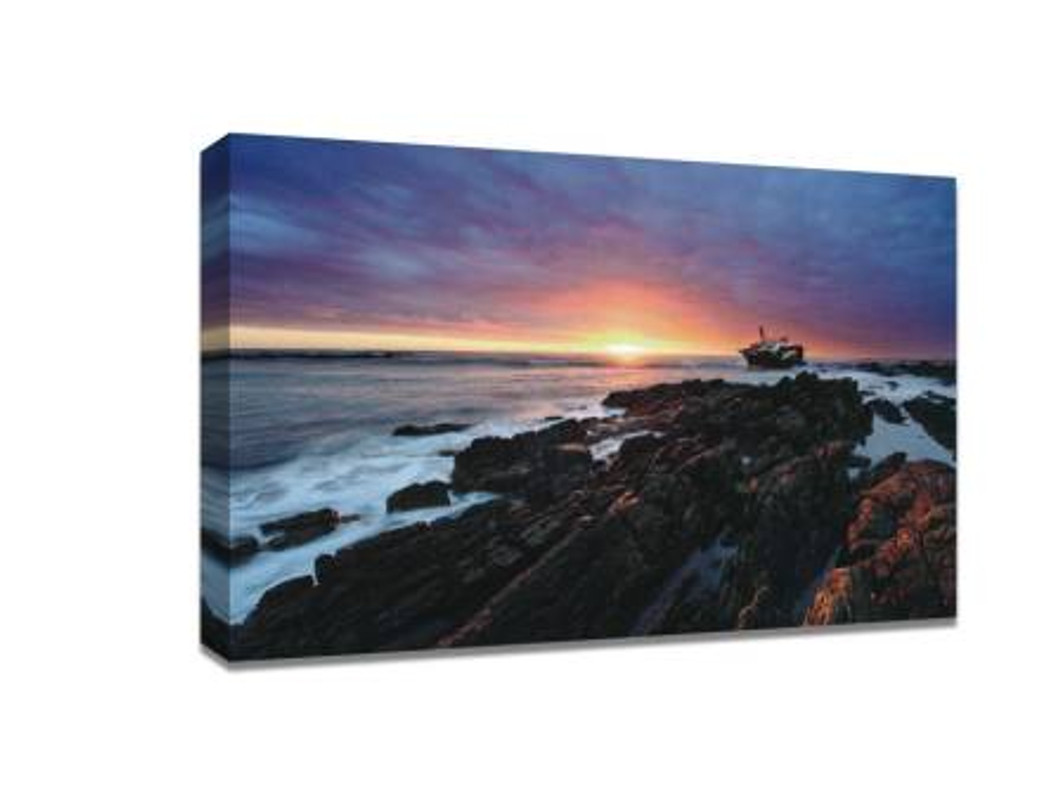The key element in shooting scenery
Ansell Adams, the great landscape photographer, once said that the art of composition in a good landscape picture is to know the best place to stand. This is a very good point. The viewpoint is the key to the success or failure of a landscape photograph. Should you stand at the bottom of the waterfall and emphasize its height and scale with a low Angle, or take a shot from above of a large amount of water pouring out of the cliff? You choose the point of view to interpret your interpretation of the scenery. Also, choosing an unusual viewpoint can bring a new interpretation to a heavily photographed location or popular attraction and help your photos stand out.
The choice of lens is equally important - to use a wide-angle lens to add foreground elements to a wider scene, or to use a telephoto lens to separate out the local elements of the scene? Using a wide-angle lens to shoot a scene from a low Angle, or a telephoto lens to lock certain elements in the same scene from a high position, will produce a very different picture and interpretation. Some landscape photographers envision what they want to photograph and then look for viewpoints and lenses to achieve the desired effect. Other photographers work in the same location for several days, shooting different compositions at different points of view with different lenses ranging from telephoto to wide-angle. Regardless of the method of creation, the choice of viewpoint and lens is an important step in determining the composition of a picture and realizing your interpretation of a landscape or place.
You often make the best of what nature has to offer. But if you're in the wrong place, or have only a poor view that's obscured, you'll be worse off than missing the magnificent beams of light that penetrate the clouds. Fortunately, this situation is not difficult to avoid, for most landscape photography, the solution is the right planning and preparation. Experienced landscape photographers often visit the same location many times without a camera to analyze the best vantage point for their interpretation of the landscape.
Still subjects, moving photographers
Portrait or still life photographers can easily change the position of their subjects or adjust the lighting in the studio -- but for landscape photographers, such a change might mean miles of mountain roads. The first step in creation is to envision the scene. You may already be familiar with local or favorite attractions, or have seen pictures of them in books, magazines, or online research. Anticipating the type of photo you're going to take can help you save time when you visit an attraction (whether it's a photo shoot or a photo shoot), but most importantly, it can provide a foundation for your work. Or, you can grope around after arriving at the attraction and risk missing the light or sunset to find something different.
If anticipation is the starting point, all you need to do is find the right perspective to implement your interpretation of the scene. Is there a hill, a tree, a rock or a building in the foreground or in the middle that blocks the view, obscuring the main focus or interest element of the photograph? If so, can you climb higher, keep it out of sight, and take cleaner pictures?
Look ahead and analyze the advantages of different viewpoints (try not to bring a camera with you on your first visit). For example, if you can't get there early in the morning, you should allow enough time before sunset to analyze the advantages of different viewpoints.
One of the most important factors in selecting a viewpoint is the interaction of light and landscape. Where does the sun rise and set in the scene in different seasons? What are the effects of various elements in different directions of sunlight?
Next, think about how your viewpoint determines the potential composition. Think about what the image would look like from a different Angle, or from a higher or lower position. What are the important elements in the scene? Is it a headland, a winding river, a waterfall, or a curve on either side of a canyon? If you change the position, the view or the relationship between the main elements what happens?
Walk before the light
Getting familiar with an attraction or capturing it in advance allows you to find the best, unobstructed view and be prepared for wonderful light to pop up. One of the favorite techniques of landscape photographers is to use wide Angle lenses (such as 17-40mm lenses) to highlight prominent foreground interest points - such as flowers, rocks, boats, driftwood, etc. But why is this technique used so often? The answer is simple: we live in a three-dimensional world, but the images our cameras take are two-dimensional. Foreground interest points add depth and distance to the image. In addition, the foreground element can also be used to create a guide line, to draw the viewer's line of sight into the image, or to create a sense of texture, or to create a sense of presence for the viewer -- the foreground object seems to be within reach. The wide-angle lens will highlight the foreground object. By their nature, wide-angle lenses foreshortening objects under closer proximity - an effect known as foreshortening. This makes foreground objects more visible in the picture, adding depth and distance to the scene.
Keep the whole picture interesting
Using a wide-angle lens and adding foreground objects to the frame can effectively add a sense of space to a photograph. But you want to make sure the scale is controlled -- objects that don't matter should not stand out in the foreground.
Further foreground elements emphasize that the technique is to tilt the camera upward and downward on these elements. This will distort the perspective of the rest of the image, however this trapezoidal distortion can be repaired in post processing.
You need to be careful when applying this effect for several reasons. If the camera is set low, foreground objects (such as rocks) may block out more distant elements, and the perspective will compress the foreground, middle ground, and background too close to each other, mixing them together, resulting in a cluttered image with little sense of space or depth. However, a high viewpoint will emphasize a relatively empty medium, resulting in too much useless space between the foreground and the background. Balance is the key.

Another important consideration when using foreground elements is to maintain sufficient depth of field. Depth of field (dof) is the distance between the nearest and farthest focal points in a scene with a specific aperture setting. Landscape photographers typically use small apertures (large f values, such as f/16 or f/22) because they can produce maximum depth of field.
This distance is constant and only changes depending on the focal length of the lens and the size of the camera sensor. Some older lenses have a depth of field setting in the aperture ring, but newer lenses often have only a depth of field scale. Today's landscape photographers make use of hyperfocal distance -- the distance at which the nearest object and the object at infinity can be brought into focus. Once the hyperfocal length is set, the focus can be closed from half the distance to infinity.
Therefore, if you put a 24mm lens on a 35mm full-frame camera and set the aperture to f/16, the hyperfocal length would be 122cm. Focus the lens to 122cm, then focus from 61cm (half of the hyperfocal length) to infinity.
This is a really useful tool for landscape photographers because we know that with this setup, everything can be focused from 61cm away to infinity. This is useful information when we incorporate foreground elements into a broad scene. Using foreground objects through a wide-angle lens does bring a photo to life, but foreground elements and backgrounds must match, otherwise the image lacks cohesion and clarity.
Perspective drawing
The inclusion of foreground elements in a wide scene creates depth and distance and draws the viewer's gaze into the image. Challenge the composition from far to nearby choosing a location that can be an agricultural scene, a mountain range, a stretch of coastline, a prairie, an empty beach, etc. Then you use a wide Angle lens to shoot a wide scene with prominent foreground elements and other background elements. You may decide on the plot or information in a photo before you visit the location, or after you arrive, but you must connect the various elements of the picture with a common theme, message, or visual cue. You can use themes to dominate these elements, such as human control of nature, the passage of time, the source of a river or waterfall, etc. You can also achieve unity by simply balancing the foreground with the textures, shapes and patterns of the sky or horizon.
Thematic harmony
By taking close-up shots of the water above and around the rocks, the foreground area of the image is closely related to the ocean that extends deep into the scene.
Harmony of colors
In the photo, the warmer colors link the foreground to the background, and the more green mid-shot becomes more defined.
Recent Posts
-
Big Canvas Prints for Coastal Homes in Australia: Beach Vibes for Every Room
Australia's coastline is renowned for its natural beauty, with sweeping sandy beaches, crystal-clear …1st Jul 2025 -
Cheap Canvas Prints with Free Delivery: A Budget-Friendly Way to Add Art to Your Walls
When it comes to decorating your home, wall art can make a huge impact without the need for a comple …1st Jul 2025 -
5 Reasons to Choose Floating Frame Canvas Prints for Your Artwork
When it comes to displaying artwork, the frame you choose can make all the difference. If you're loo …1st Jul 2025
